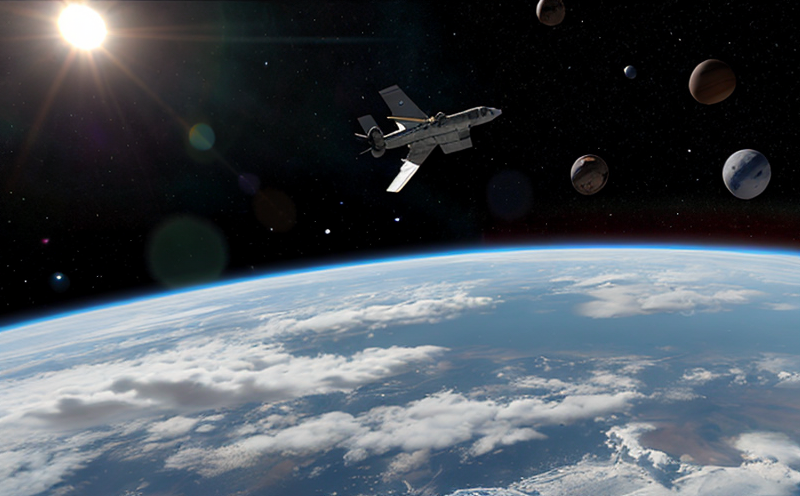NASA GSFC-STD-7000 Spacecraft Thermal Balance Testing
The NASA GSFC-STD-7000 Spacecraft Thermal Balance Test is a critical component of spacecraft design and development, ensuring that the thermal control systems function as expected in the extreme conditions encountered during space missions. This test is essential for verifying that the spacecraft maintains the required operating temperatures, which are crucial for the successful operation of all on-board instruments and subsystems.
The thermal balance test involves exposing a model or prototype of the spacecraft to simulated space environments, including variations in solar radiation, vacuum conditions, and temperature fluctuations. The objective is to ensure that the spacecraft can maintain stability within specified temperature ranges without overheating or freezing up during mission operations. This testing is particularly important for missions involving deep space exploration, where the thermal environment can vary dramatically from Earth.
During the test, we simulate various environmental conditions using specialized chambers and equipment. These include solar radiation simulators to replicate the sun's energy, vacuum chambers to mimic the near-vacuum conditions of space, and temperature-controlled environments that can range widely depending on the mission requirements. The spacecraft model is subjected to these conditions for extended periods to observe its thermal behavior.
The test setup typically involves placing the spacecraft model in a controlled environment where it is exposed to different levels of solar radiation and vacuum. Temperature sensors and other monitoring equipment are strategically placed throughout the spacecraft to measure temperature variations accurately. This data helps us assess how well the spacecraft's thermal control systems perform under these conditions.
The NASA GSFC-STD-7000 test is not just a theoretical exercise; it has real-world implications for mission success. For instance, during the Mars Science Laboratory (Curiosity) mission, the spacecraft had to withstand extreme temperature changes as it descended through the Martian atmosphere and landed on the planet's surface. The thermal balance test ensured that the rover could operate within its operating temperatures despite the harsh conditions.
Understanding the complexities of space environments is paramount for ensuring the longevity and functionality of spacecraft. By simulating these conditions, we can identify potential issues early in the development process and make necessary adjustments to the design before full-scale mission operations begin.
| Applied Standards | Description |
|---|---|
| NASA GSFC-STD-7000 | This standard outlines the requirements for spacecraft thermal balance testing, including environmental conditions and test procedures. |
| AIAA S-087-1995 | These standards provide guidelines on thermal design practices for space systems, which are essential for understanding the thermal environment during the test. |
The data collected from these tests is invaluable in ensuring that spacecraft can meet mission requirements. For example, the International Space Station (ISS) uses this type of testing to ensure its solar arrays and other critical systems operate within specified temperature ranges. This ensures the safe and efficient operation of the station's various modules.
Applied Standards
| Standard | Description |
|---|---|
| NASA GSFC-STD-7000 | This standard provides the requirements for spacecraft thermal balance testing, including environmental conditions and test procedures. |
| AIAA S-087-1995 | These standards outline thermal design practices for space systems, which are critical for understanding the thermal environment during the test. |
The NASA GSFC-STD-7000 standard is particularly important as it provides a framework for conducting this type of testing. It specifies the environmental conditions that must be replicated in the test chamber, such as solar radiation levels and vacuum pressures. Additionally, it outlines the procedures for monitoring temperature variations throughout the spacecraft model.
The AIAA S-087-1995 standards complement these requirements by providing guidelines on thermal design practices. These include considerations for heat rejection, insulation, and other factors that influence the spacecraft's thermal performance. By adhering to these standards, we ensure that our testing accurately reflects real-world conditions.
Benefits
- Identifies potential issues early in the development process
- Ensures compliance with NASA and industry standards
- Provides data for optimizing thermal control systems
- Enhances mission success by ensuring spacecraft can operate within specified temperature ranges
- Saves costs associated with corrective actions during later stages of development
- Promotes the safe operation of critical subsystems, including solar arrays and avionics
- Supports the longevity of spacecraft in challenging space environments
The benefits of NASA GSFC-STD-7000 testing extend beyond just identifying issues; it also provides a means to optimize thermal control systems. By understanding how the spacecraft behaves under different environmental conditions, we can make informed decisions about system design and configuration.
Compliance with industry standards like NASA GSFC-STD-7000 ensures that our tests are rigorous and meet the highest quality benchmarks. This not only enhances mission success but also promotes the safe operation of critical subsystems such as solar arrays and avionics. The data gathered from these tests is crucial for optimizing thermal control systems, which in turn supports the longevity of spacecraft in challenging space environments.
Why Choose This Test
- Ensures compliance with NASA standards
- Promotes mission success by verifying thermal balance under extreme conditions
- Provides critical data for optimizing thermal control systems
- Saves costs associated with corrective actions during later stages of development
- Enhances safety and reliability of spacecraft operations
- Supports the design and development of future space missions
- Promotes industry best practices in thermal engineering
The NASA GSFC-STD-7000 Spacecraft Thermal Balance Test is a cornerstone of spacecraft development, ensuring that the thermal control systems meet stringent requirements for operation in extreme environments. By choosing this test, you are investing in the safety and reliability of your spacecraft. This ensures mission success by verifying that the spacecraft can maintain stable temperatures under conditions similar to those it will encounter during its journey.
The data collected from these tests is invaluable for optimizing thermal control systems, which ultimately supports the longevity of spacecraft in challenging space environments. By adhering to NASA standards and best practices in thermal engineering, you are setting a high bar for quality and reliability that can be leveraged across future space missions.





